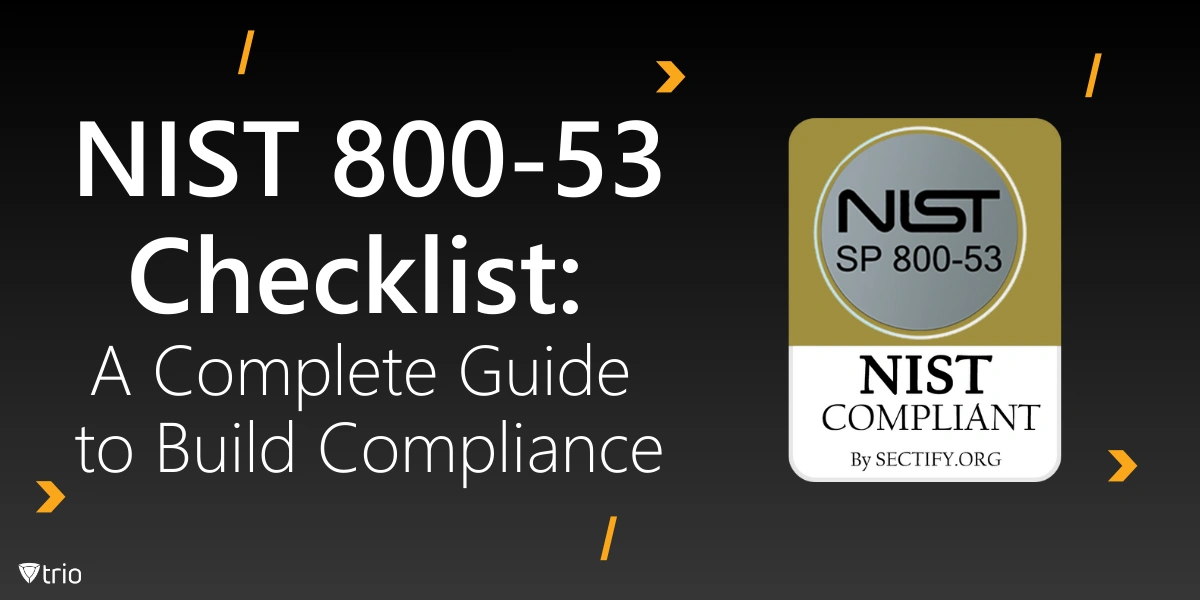The National Institute of Standards and Technology (NIST) 800-53 is one of the most critical frameworks for federal organizations and contractors handling sensitive government data. It provides a catalog of security and privacy controls to safeguard systems and data from various threats. This blog will explore what a NIST 800-53 checklist entails, its significance, and how to create an actionable checklist for compliance.
What Is NIST 800-53?
NIST Special Publication 800-53 outlines security and privacy controls for federal information systems and organizations. It was designed to ensure confidentiality, integrity, and availability across various environments, including cloud, on-premises, and hybrid systems.
The framework is based on the Risk Management Framework (RMF), which emphasizes identifying and mitigating risks through structured processes. NIST 800-53 organizes its controls into 20 families, including Access Control (AC), Risk Assessment (RA), and Incident Response (IR). Each family focuses on a specific security or privacy area.
The latest revision, NIST 800-53 Rev 5, expands its scope beyond federal agencies to include private organizations and introduces a more dynamic approach to risk and compliance management.
Why Is NIST 800-53 Important?
Adhering to NIST 800-53 offers several benefits, such as:
- Compliance: Required for federal contractors and agencies working with sensitive information.
- Enhanced Security: Strengthens an organization’s ability to defend against sophisticated cyberattacks.
- Standardization: Provides a unified set of controls for diverse systems and environments.
- Adaptability: Helps organizations scale their security measures as new threats emerge.
Failure to comply with NIST 800-53 can result in penalties, loss of contracts, or reputational damage.
Key Components of NIST 800-53
The framework’s 20 control families include over 1,000 controls. Here are some of the most critical components:
- Access Control (AC): Policies and procedures for managing user access.
- Audit and Accountability (AU): Tracking and logging system activities.
- System and Communications Protection (SC): Safeguards for secure data transmission.
- Incident Response (IR): Processes for detecting and responding to breaches.
- Risk Assessment (RA): Identifying vulnerabilities and assessing their potential impact.
Each control is associated with one of three impact levels: Low, Moderate, or High, depending on the severity of harm a compromise could cause.
How to Create a NIST 800-53 Checklist
Developing a NIST 800-53 controls list involves a detailed approach to map the framework’s controls to your organization’s operations.
1. Understand Your Security Requirements
- Assess Your System Type: Identify whether your systems handle Low, Moderate, or High-impact data.
- Determine Applicable Controls: Not all controls in NIST 800-53 apply to every organization. Use the tailoring process to select relevant controls.
- Evaluate Regulatory Requirements: If your organization must comply with additional frameworks, such as HIPAA or FedRAMP, map overlapping controls.
2. Organize Controls by Families
Group the controls by the 20 families and break them down into manageable sections. Examples:
- Access Control (AC): Ensure role-based access policies are implemented.
- Risk Assessment (RA): Perform regular vulnerability assessments and maintain a risk log.
3. Assign Responsibility
For each control, assign a responsible party. Examples include:
- IT Administrators: Implement and monitor technical controls.
- Compliance Officers: Ensure procedural and policy controls are followed.
- Third-Party Auditors: Validate compliance efforts.
4. Develop a Scoring System
Create a scoring system to track your compliance progress. For instance:
- 0%: No control implemented.
- 50%: Partial implementation.
- 100%: Fully implemented and validated.
5. Monitor and Update Regularly
- Periodically review the checklist to incorporate changes in your infrastructure or updates in NIST guidance.
- Conduct internal NIST 800-53 audits and external reviews to ensure compliance.

NIST 800-53 Compliance Checklist Example
This template is designed to assist IT administrators in organizing and documenting their efforts to comply with NIST 800-53 security and privacy controls. It can be customized to meet the specific needs of your organization.
Section 1: General Information
- Organization Name
- Prepared By
- Date Created
- Last Updated
- System Name
- Impact Level: Low, Moderate, or High
- Applicable Regulatory Requirements: List specific requirements such as FedRAMP, HIPAA, or FISMA
Section 2: Control Family Checklist
Access Control (AC)
Ensure that access to systems is authorized and unauthorized activities are prevented. Identify the status of key controls like account management, access enforcement, and separation of duties. Note who is responsible for each control and any implementation challenges.
Audit and Accountability (AU)
Maintain logs and ensure system accountability. Focus on controls such as defining audit events, responding to audit processing failures, and generating audit records. Assign team members to oversee these tasks and document progress.
Configuration Management (CM)
Establish secure configurations for IT systems. Key tasks include creating baseline configurations, managing configuration changes, and ensuring that security settings are consistently applied. Regularly review progress and update as necessary.
Risk Assessment (RA)
Identify and address potential vulnerabilities. Critical controls include security categorization, performing risk assessments, and conducting vulnerability scanning. Clearly define roles and responsibilities to ensure timely completion.
Incident Response (IR)
Prepare to detect, respond to, and recover from security incidents. Ensure controls like incident response training, incident handling, and testing of response plans are implemented. Keep track of updates and document lessons learned.
Section 3: Tailoring and Customization
- Excluded Controls: Document controls that are not applicable to your organization’s environment and explain the rationale.
- Compensating Controls: Describe alternative measures implemented to meet compliance requirements where standard controls are not feasible.
Section 4: Scoring and Metrics
Assess progress for each control family by tracking the number of controls implemented, in progress, or not started. Calculate compliance percentages to identify areas requiring immediate attention and allocate resources accordingly.
Section 5: Supporting Tools and Resources
- Tools in Use: Examples include vulnerability scanners (e.g., Nessus, Qualys), log management systems (e.g., Splunk), and configuration management software (e.g., Ansible, Puppet). Mobile Device Management (MDM) solutions can also support endpoint compliance by enforcing access control and ensuring proper configuration management.
- Training Resources: Utilize platforms like the NIST Cybersecurity Framework Learning Portal and the Federal Virtual Training Environment (FedVTE) for continuous learning and staff training.
Section 6: Review Schedule
- Quarterly Reviews: Conduct detailed assessments of compliance progress every three months.
- Annual Audit: Complete a comprehensive review of all controls annually.
- Trigger Events: Perform additional reviews following security incidents, major system upgrades, or changes in regulatory requirements.
Section 7: Approval and Sign-Off
- Prepared By: Include the name, role, and date of the individual responsible for preparing the checklist.
- Reviewed By: Document the name, role, and date of the person who reviewed the checklist for accuracy and completeness.
- Approved By: Record the name, role, and date of the individual responsible for final approval.
This NIST 800-53 checklist template offers a structured method to assess and document compliance with NIST 800-53 controls. Modify it as needed to align with your organization’s operations, goals, and regulatory requirements.
Tools for NIST 800-53 Compliance
Adhering to NIST 800-53 requires specialized tools and platforms to streamline the process:
- Policy Management Platforms: Automate control assignments and documentation.
- Risk Management Solutions: Identify, assess, and mitigate risks effectively.
- Auditing Tools: Generate logs and track compliance in real time.
- Mobile Device Management (MDM): Secure endpoints to meet technical controls for access and device management.
Challenges in NIST 800-53 Compliance
Some of the challenges in NIST 800-53 compliance include:
1. Complexity of Controls
The sheer number of controls can be overwhelming for smaller organizations.
2. Lack of Expertise
Without experienced personnel, interpreting and implementing controls may be challenging.
3. Continuous Monitoring
Maintaining compliance requires ongoing assessments and updates, which can strain resources.
4. Integration with Existing Frameworks
Aligning NIST 800-53 with other frameworks like ISO 27001 or SOC 2 adds complexity.
How Trio Can Help with NIST 800-53 Compliance
Trio’s Mobile Device Management (MDM) solution simplifies the implementation of NIST 800-53 technical controls. Key benefits include:
- Streamlined Access Control: Enforce device-level access policies.
- Secure Communication: Encrypt data transmissions across all connected endpoints.
- Real-Time Monitoring: Track compliance status through centralized dashboards.
- Incident Response Support: Enable rapid response to breaches via remote device management.
Free NIST 800-53 Compliance Checklist
A NIST 800-53 compliance checklist helps organizations track adherence to federal security standards. By organizing the 20 control families, assigning responsibilities, and monitoring progress, organizations can ensure compliance with security and privacy controls. Regular updates and reviews keep the checklist aligned with evolving threats and regulations, helping mitigate risks and protect sensitive data.
See Trio in Action: Get Your Free Trial Now!
Conclusion
Building a NIST 800-53 checklist is crucial for organizations aiming to comply with federal security standards and protect sensitive information. By understanding your requirements, tailoring controls, and leveraging the right tools, you can ensure comprehensive compliance while minimizing risks. Trio offers a robust solution to simplify compliance efforts and enhance security. Discover how Trio can streamline your NIST 800-53 compliance efforts. Start your free trial today!




